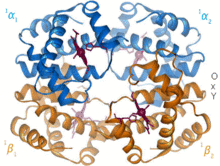Complex formation reaction
A complex-forming reaction is a chemical reaction (transformation and part of the complex reactions ) from the field of complex chemistry , in which a metal - cation with molecules or ions , reacts as Lewis bases their free pairs of electrons to form a coordinate bond filters with the cation available . The molecule or ion is referred to as a ligand . Complex formation reactions are often characterized by color changes. In the empirical formula and in the reaction scheme , the complex is indicated by square brackets, in which the central atom such as B. a copper cation and the ligands in round inner brackets (example: [Cu (NH 3 ) 4 ] 2+ ).
Examples of complex formation reactions
Formation of the hexaqua copper complex
Anhydrous, white copper sulfate turns light blue when water is added - a detection reaction for water. The result is an aqua complex of copper in which six water molecules appear as ligands of the central ion, whereby the two axially located ligands are significantly further away from the central ion ( Jahn-Teller effect ):
Formation of the tetraammine copper complex
Copper (II) salts also produce deep blue complex salt solutions with ammonia solution at pH values above 8 (copper tetraammine complex [Cu (NH 3 ) 4 ] 2+ - also referred to as tetraammine copper (II), see illustration of this detection reaction ):
The copper tetraammine complex, like the copper hexaaqua complex, is doubly positively charged, as 4 neutral molecules bind to the central atom (strictly speaking 4 + 2 molecules, namely 4 NH 3 and 2 H 2 O; Jahn-Teller effect ). However, if anions such as. B. If chloride anions bind to the central atom, the complex can also be negatively charged (e.g. the green tetrachlorocuprate II complex is doubly negatively charged):
Anionic complexes are named differently (metal name with the ending -at at the end of the name) and are also of great importance in biochemistry .
Formation of the nickel-dimethylglyoxime complex
Nickel salt solution forms complexes with an alcoholic dimethylglyoxime solution (DMG). The raspberry-red nickel-dimethylglyoxime precipitates as a complex in ammoniacal solution :
In contrast to the copper tetrammine or copper tetraquo complex, this complex is neutral and insoluble in water.
Complex formation as a balance
Such Lewis acid-base reactions for complex formation are equilibrium reactions for which the law of mass action can be established. The resulting equilibrium constant is called the complex formation constant. It also indicates how stable the complex is and whether it tends to dissociate. Its reciprocal is called Komplexdissoziationskonstante K D designated so K A -1 = K D .
Classification and importance of complex formation reactions
In addition to the complex formation reaction, there are also ligand exchange and dissociation reactions in complex chemistry in which complexes are created or broken down again. Many complex formation reactions are of great importance in areas such as catalysis, biochemistry, dye chemistry, analytical chemistry with their detection reactions, especially for cations in the cation separation process and chemical technology.
Many colored complexes are also used to research atomic and molecular structures (e.g. the chromium-hexamine complex, figure, or the new sandwich complexes ), metabolic processes ( hemoglobin in breathing, chlorophyll in photosynthesis, complexes with iron sulfide Minerals in chemical evolution and the creation of life ("iron-sulfur world", see under chemical evolution ), many enzymes, some vitamins), light-matter interactions (pigments and dyes) and catalytic processes.

![{\ mathrm {CuSO_ {4} +6 \ H_ {2} O \ longrightarrow [Cu (H_ {2} O) _ {6}] ^ {{2 +}} + SO_ {4} ^ {{2-} }}}](https://wikimedia.org/api/rest_v1/media/math/render/svg/fec1a75e061a77a88df2e3e6becd39affc8cc852)
![{\ mathrm {Cu ^ {{2 +}} + 4 \ NH_ {3} \ longrightarrow [Cu (NH_ {3}) _ {4}] ^ {{2+}}}}](https://wikimedia.org/api/rest_v1/media/math/render/svg/6d37f99210a906f5833072eb5d2ba02dd91bb36b)
![{\ mathrm {Cu ^ {{2 +}} + 4 \ Cl ^ {-} \ longrightarrow [Cu (Cl) _ {4}] ^ {{2-}}}}](https://wikimedia.org/api/rest_v1/media/math/render/svg/68e32ef65467cf0c29d036fd7e7191c84f6b96f7)

![{\ mathrm {[Ni (C_ {4} H_ {7} N_ {2} O_ {2}) _ {2}] + 2 \ H ^ {+}}}](https://wikimedia.org/api/rest_v1/media/math/render/svg/830f7b97e6beeeedd65d385f2942bdd372563bae)
